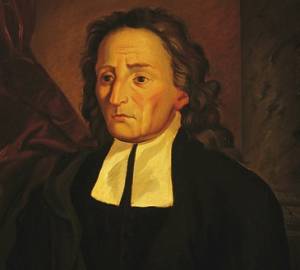Giambattista Vico and James Joyce's Finnegans Wake
The view of history in Finnegans Wake is very strongly influenced by Giambattista Vico. Vico propounded a cyclical view of history, in which civilization rose from chaos, passed through theocratic, aristocratic, and democratic phases, and then lapsed back into chaos.
The most obvious example of the influence of Vico's cyclical theory of history is to be found in the opening and closing words of the book. Finnegans Wake opens with the words “riverrun, past Eve and Adam's, from swerve of shore to bend of bay, brings us by a commodius vicus of recirculation back to Howth Castle and Environs.” (“vicus” is a pun on Vico) and ends “A way a lone a last a loved a long the”. In other words, the book ends with the beginning of a sentence and begins with the end of the same sentence, turning the book into one great cycle. Indeed, Joyce said that the ideal reader of the Wake would suffer from “ideal insomnia” and, on completing the book, would turn to page one and start again, and so on in an endless cycle of reading.
In the final two chapters of Book I we learn more about the letter's writer Shem the Penman (I.7) and its original author, his mother ALP (I.8). The Shem chapter consists of “Shaun's character assassination of his brother Shem”, describing the hermetic artist as a forger and a “sham”, before “Shem is protected by his mother [ALP], who appears at the end to come and defend her son.” The following chapter concerning Shem's mother, known as “Anna Livia Plurabelle,” is interwoven with thousands of river names from all over the globe, and is widely considered the book's most celebrated passage.
The chapter was described by Joyce in 1924 as “a chattering dialogue across the river by two washerwomen who as night falls become a tree and a stone.” These two washerwomen gossip about ALP's response to the allegations laid against her husband HCE, as they wash clothes in the Liffey. ALP is said to have written a letter declaring herself tired of her mate. Their gossip then digresses to her youthful affairs and sexual encounters, before returning to the publication of HCE's guilt in the morning newspaper, and his wife's revenge on his enemies: borrowing a “mailsack” from her son Shaun the Post, she delivers presents to her 111 children. At the chapter's close the washerwomen try to pick up the thread of the story, but their conversation is increasingly difficult as they are on opposite sides of the widening Liffey, and it is getting dark. Finally, as they turn into a tree and a stone, they ask to be told a Tale of Shem or Shaun.
Fichman, Jordan. “Giambattista Vico and James Joyce's Finnegan's Wake.” 8/3/10. <http://www.artlegends.org/2010/08/giambattista-vico-and-james-joyces.html>
